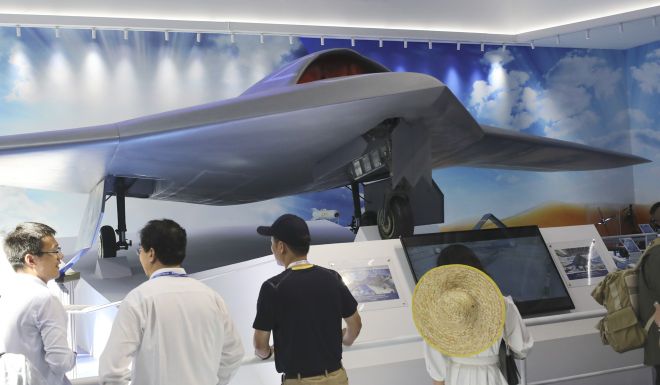
Img Credit: Yahoo News Singapore
China continues to impress with their latest innovation, new stealth combat drones known as Tian Ying (CH-7). It featured at the air show in Zhuhai, a biannual event that showcases China’s latest developments in military and civilian aviation. There were several Chinese state-owned arms companies also displaying their drones. It appears China is investing heavily in unmanned aircraft with plans to develop drones capable of flying from one of its future aircraft carriers. Could this be a role for the CH-7 to fulfil?
According to China’s Ministry of Industry and Information Technology, more than 350 private Chinese firms are now capable of making unmanned aerial, surface or ground vehicles. Figo Zhang, chief executive of Yunzhou Technology said, “We are seeing a bubble around artificial intelligence and especially in the unmanned vehicles industry, a serious bubble”.
CH-7 Stealth Combat Drones Specifications
A model of one of the newest stealth combat drones was on display at the Zhuhai air show in southern China and attracted a large number of visitors. It’s no surprise really as the drone looks futuristic, technologically advanced and intimidating.
The CH-7 has a wingspan of 22 meters (72 feet) and a length of 10 meters (33 feet). The drone is practically the same size as a normal combat aircraft with a single engine capable of reaching 200km/h (124 mph) while remaining airborne for up to 40 hours. This latest development is a clear indication of the country’s growing aerospace prowess.
Chief designer Shi Wen said that the aircraft can “fly long hours, scout and strike the target when necessary. Very soon, I believe, in the next one to two years, (we) can see the CH-7 flying in the blue skies, gradually being a practical and usable product in the future.”
The manufacturer, Chinese Aerospace Science and Technology Corporation (CASC), has plans for a test flight as early as next year with mass production set for 2022.
The stealth drone project follows their successful test of a cutting-edge hypersonic aircraft, Starry Sky-2. According to China Daily, during a test flight on August 3, the hypersonic aircraft maintained speeds higher than Mach 5.5 for longer than 400 seconds and reached a top speed of 7,344 km/h (4,563 mph).
This is similar to the technology that Russia and the US are developing and can even house conventional or nuclear warheads. The craft’s speed and unpredictable trajectory will truly challenge any modern missile defence system.
Looking at these impressive engineering feats and with Israel and the US also developing their own stealth drones, the question is, ‘what comes next?’
Stealth Combat Drones Across The Globe
The CH-7 UAV is a clear indication of China’s growing interest, competitiveness and success in expanding the global drone market. While the US may have a technological advantage and even with Russia, Israel and France competing on a global scale, China beats everyone when it comes to price. They have confirmed orders from the Middle East and elsewhere selling drones at much lower prices and without the political drawbacks associated with the US.
While Israel has been long known as the leader in UAV development, many Chinese companies have taken a big share in the international arena. In fact, DJI, a Shenzhen-based private firm currently leads the global market for commercial drones. Many new tech companies are focusing on the military sector primarily because of Beijing’s policy to use more private companies as defence suppliers.
One of the main reasons why China’s stealth combat drones are winning favour across the Middle East is because countries are being locked out of purchasing American-made drones. This comes after ruling that there are excessive civilian casualties which play right into the hands of Chinese arms dealers. As a result, they are now the world’s largest distributor of armed combat drones.
The fact that China is not part of the Missile Technology Control Regime has helped their sales efforts tremendously. This is because they are not restricted to export missiles and other unmanned weapons systems. This has helped expand Chinese influence across a region crucial to American security interests while strengthening Beijing’s ambitions to be a front-runner in high-tech arms deals.
Additional Defence Projects – Stealth Fighters
Other defence projects on display at the Zhuhai airshow was China’s homebuilt J-20 stealth fighter. There is no denying that it closely resembles Lockheed Martin’s F-22 Raptor currently in service with the US military.
The Chinese J-10B fighter also showed off its vectoring thrust, featuring an engine equipped with a hinged nozzle. Vectoring thrust technology enables aircraft to direct their propulsion which results in added flexibility when manoeuvring.
Spectators were thrilled by the jet fighters on display and even those not familiar with tech could see how China has grown. There is a real feel that China is changing and that they are getting stronger slowly with growing international status.
The Chinese government expects the demand for military applications to increase, particularly in the drone industry. As a senior official at the Ministry for Industry and Information Technology stated, their UAV industry alone was worth $3.3bn in 2017 with even bigger forecasts. It could reach $8.5bn in 2020 and $25.5bn in 2025 with the defence sector playing a vital role.
Read the full article on the Zhuhai air show, the stealth combat drones and China’s newest weapons of war.
For more interesting articles on emerging technology, advanced engineering and manufacturing, visit our blog site. PRV Engineering manufacture for a wide range of industries including automotive, aerospace, defence and rail among others. Get in touch with if you require any assistance with your project or have questions about what we can do.
This site uses Akismet to reduce spam. Learn how your comment data is processed.


 Mail:
Mail: 




Leave a Comments